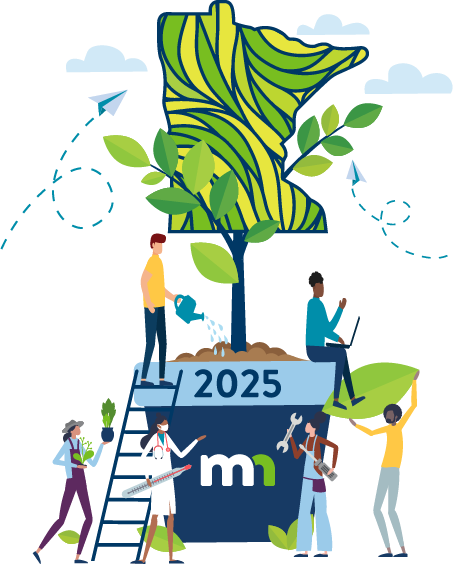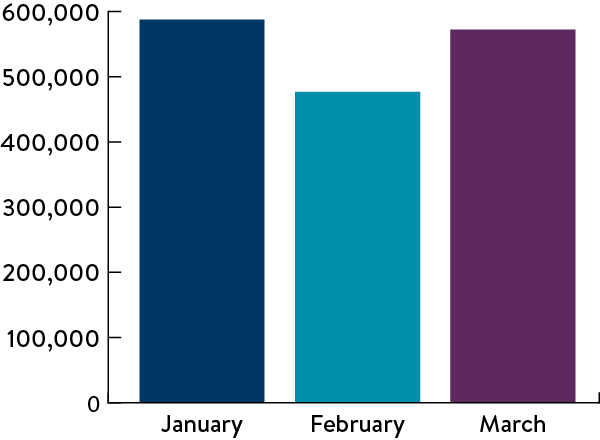


This quarter, MNIT established the Human and Social Digital Services (HSDS) division to strengthen the digital infrastructure behind some of the state’s most essential programs. HSDS supports technology systems that serve counties, families, and individuals across Minnesota by partnering with the Department of Human Services (DHS), MNsure, the Department of Children, Youth, and Families (DCYF), and Direct Care and Treatment (DCT).
The division brings together experts in application development, engineering, and enterprise architecture to ensure the reliability and efficiency of these critical systems. Using a DevOps model, HSDS fosters collaboration, automation, and continuous delivery—reducing operational risk, closing gaps in future IT models, and improving support for both shared and agency-specific applications.
By launching HSDS, MNIT is expanding its capacity to deliver secure, human-centered digital services that improve outcomes and access for all Minnesotans.
During Public Service Recognition Week, MNIT proudly honored the dedication and resilience of our team. Every day, our staff brings talent, creativity, and commitment to delivering secure, efficient, and innovative technology services for the State of Minnesota. From launching new digital tools to safeguarding critical systems, their work strengthens government operations and improves service for Minnesotans across the state.

Minnesota received a 2025 Special Achievement in GIS (SAG) Award from Esri for the Executive Map Portfolio—an interactive suite of maps developed through a partnership between the Office of Governor Tim Walz and Lieutenant Governor Peggy Flanagan and MNIT’s Geospatial Information Office (MnGeo). The tool helps state leaders visualize key data from the One Minnesota Plan across three areas: climate, children and families, and the economy.
Built using ArcGIS technology and designed for mobile use, the portfolio supports quick, informed decision-making while promoting public transparency. The project brought together MNIT technologists, policy and communications staff, agency experts, and academic partners.
Explore the Executive Map Portfolio to learn more.
The Executive Map Portfolio is more than a tool—it’s a reflection of our commitment to equity, transparency, and data-informed leadership.
–Alison Slaats, MnGeo Director
Minnesotans navigating the workers’ compensation system now benefit from a more efficient, accessible, and user-friendly experience. With a $1 million TMF investment approved in April 2024, MNIT partnered with DLI and delivered key upgrades to the Campus platform—improving usability for injured workers, attorneys, insurers, and rehabilitation providers.
Campus, launched in 2020, serves as the digital system of record for Minnesota’s workers’ compensation program, managing more than 2 million claims. While the platform met basic functional needs, users frequently encountered issues that made routine tasks time-consuming and frustrating. With support from the TMF, DLI and MNIT were able to focus on resolving these challenges—transforming Campus into a more intuitive, efficient, and user-centered system that better supports the people who rely on it every day.
This effort shows how targeted investment can transform digital services that matter to Minnesotans. By making Campus easier to use and more reliable, DLI and MNIT are improving service delivery today—and laying the groundwork for continued progress in the years ahead.
MNIT partnered with the Department of Corrections (DOC) to launch MnSTARR 3.0, a modernized version of the state’s recidivism risk assessment tool. This upgrade replaces the older MnSTARR 2.0 system, improving both performance and transparency.
MnSTARR 3.0 empowers staff with greater control over the algorithms used to assess an incarcerated person’s (IP’s) likelihood of recidivism. The system now provides clearer insight into the values and weights behind each score, enabling more informed decision-making. It also enhances communication and trust by giving staff and IPs access to detailed information about risk levels, percentile rankings, and how those figures are calculated.
By delivering improved transparency and flexibility, MnSTARR 3.0 strengthens Minnesota’s person-centered approach to rehabilitation and public safety.
On June 10, the legislature adjourned after completing its work setting the state’s biennial budget. This marathon one-day special session followed the adjournment of regular session on May 19.
The biennial budget includes funding for important priorities across the administration, along with operating adjustments that fund our agency operations. These investments ensure that MNIT and our agency partners can continue doing the important work we do.
Beyond operational funding, also included in the biennial budget is critical investment to modernize Minnesota’s Child Welfare Information System – currently administered through the Social Services Information System (SSIS). The $35 million provided by the Health and Human Services omnibus bill, Chapter 3 (2025, Special Session), will enable Minnesota to embark on modernizing programs that support over 150,000 of Minnesota’s most vulnerable children. Child welfare modernization will be a critical focus for MNIT and our partners at DCYF, and we are eager to advance this priority for Minnesota’s children.
Beyond child welfare modernization, the legislature also advanced funding to support ongoing modernization efforts at DOC and DHS. Additionally, they allocated resources to enhance technology support capacity at key agencies. MNIT is proud to have worked closely with critical legislative partners, the Governor’s Office, our state agency business partners, and members of the Technology Advisory Council (TAC) as we advanced critical digital service needs for Minnesotans.
Amid the investments and advancements of this legislation, MNIT and our business partners remain dedicated to advancing the historic modernization and transformation initiatives from the 2023 legislative session. As these efforts continue to transform how Minnesotans interact with their state government, it is essential to keep our customers at the heart of the services we support—ensuring we continue to deliver a modern, inclusive digital government that works for everyone.
At this year’s Global Accessibility Awareness Day (GAAD), Minnesota’s legislative and judicial branches shared how they are working to embed accessibility into everyday operations, highlighting a growing culture of inclusion across government.
Both branches are using MNIT’s accessibility toolkit and participating in initiatives like the “No Mouse Challenge” and the hands-on Digital Accessibility Experience Lab—giving staff a firsthand look at how people navigate digital barriers.
Accessibility is no longer a secondary concern— it’s a core expectation. These efforts demonstrate a deepening commitment to digital equity and public service, ensuring all Minnesotans can access, engage with, and benefit from their government.
To deliver secure, modern, and accessible digital services, the Minnesota Legislature established the Technology Modernization Fund (TMF) with a $40 million investment over four years starting in 2023.
Managed by MNIT, the TMF supports projects that modernize technology, strengthen cybersecurity, and improve the digital experience for Minnesotans. A cross-agency steering team reviews proposals and oversees progress.
TMF projects focus on:
Department of Labor and Industry
This project helps DLI align legacy data with current record retention schedules—improving compliance and supporting informed decisionmaking. It also prepares the agency to select a secure, modern storage solution tailored to business needs, while reducing risks such as data loss, vendor delays, and cybersecurity threats.
Minnesota Department of Agriculture
This project will serve more than 65,000 license, permit, and certificate holders by introducing digital customer accounts and self-service tools. It will allow users to view and update their information and begin applications in advance. The solution will enhance service levels, increase transparency, support legal compliance, and lay the foundation for LoginMN integration and proactive customer engagement.
MNsure
This initiative transitions the MNsure Contact Center to a modern, cloud-based solution. It will deliver immediate improvements to the consumer experience while expanding functionality and enhancing overall system capabilities.
Minnesota Department of Transportation
This project will create a comprehensive snow drift prediction and blowing snow control application. The tool aims to improve road safety, mobility, and right-of-way planning for municipalities, transportation agencies, and other partners.
Minnesota Department of Human Rights
The MyCert project will modernize how more than 3,500 businesses interact with MDHR. It streamlines the application and reporting process for Workforce and Equal Pay Certificates through automation, secure messaging, and a rebuilt contractor management system. These improvements will enhance the customer experience, speed up agency procurement, and improve compliance across partners.
Public Utilities Commission
This project will modernize the Public Utilities Commission’s energy infrastructure permitting process by implementing a scalable, SaaS-based solution. It will improve workflows, project tracking, and compliance while enhancing transparency and the user experience. The effort supports long-term strategic goals and legislative mandates through a sustainable, cost-effective platform.
Bureau of Criminal Apprehension
This initiative migrates critical systems to a secure Azure Government Cloud environment, improving security and compliance with Criminal Justice Information Services (CJIS) and MNIT standards. It also enhances reliability, reduces costs, and supports technical staff development—laying the foundation for broader cloud adoption statewide.
Across Minnesota’s state agencies, teams are proving that listening to customers and focusing on their needs leads to faster service, better outcomes, and stronger trust. These case studies show how small, thoughtful changes—grounded in customer feedback—can make a big difference without adding staff or costly technology.
By redesigning processes and materials around customer needs, MDHR cut turnaround times by 30%—without adding staff or new technology. The improvement came from focused changes shaped by direct feedback.
Mapping the customer journey for cottage food licensing allowed MDA to cut processing time in half and clear its daily callback backlog—again, with no added staff or new technology. Streamlining the experience based on customer input made all the difference.
DHS partnered with students to co-design a more flexible support process for the ETV program. The redesigned program makes it easier for students to access funding and resources, helping them stay in school and graduate.
When DLI’s new workers’ compensation application fell short, the agency listened. By engaging users early and often, they rebuilt the system into a model of user-centered design, increasing satisfaction, trust, and outcomes.
These results go beyond numbers — they make a real difference in people’s lives.
One example: After MDA cut licensing times in half, a military veteran caring for elderly parents was able to start selling at a farmers market three weeks earlier than expected. The extra time meant more income for his family and a chance to honor childhood memories of visiting the market with his grandfather.
To help agencies achieve similar results, the Product, Agile, and Customer Experience – Center of Enablement (PACE) offers a 16-week cohort program. Eight teams participated in the second cohort, meeting biweekly for interactive sessions on customer experience, product management, and agile practices. Teams shared successes and challenges, with some receiving additional coaching from PACE. These proven methods help agencies deliver services that are simpler, faster, and more responsive to the people they serve.
When we center our work on customers and equip teams with the right tools, we create better experiences, strengthen trust, and deliver lasting benefits for all Minnesotans. With more agencies joining PACE cohorts, this culture of continuous improvement keeps growing—one success story at a time.
MNIT updated its organizational structure to better serve Minnesotans and our partnering agencies. Part of the reorganization included expanding the role of MNIT’s five Business Information Security Officers (BISOs), who are the main liaisons between state agency partners and MNIT security leadership. BISOs manage cybersecurity strategy, governance, and risk management while ensuring security objectives align with business goals. Each BISO is accountable for coordinating security across multiple agencies and ensuring alignment with enterprise security policies, while addressing agency-specific risks. State agencies can find their BISO in MNIT Contacts.
MNIT’s Threat and Vulnerability Management Unit (TVMU) is like a home security system that helps keep state systems and employees’ accounts and devices secure. TVMU uses sophisticated tools to scan for cyber threats, as well as look for hardware and software flaws that make devices and state systems vulnerable to a cyber-attack. TVMU and MNIT teams then use that information to resolve issues. In the second quarter, April-June 2025, TVMU identified and helped resolve 1,633,247 vulnerability instances across the executive branch. This ongoing, proactive work of TVMU and other MNIT teams helps the state stay ahead of evolving cyber threats and reduces the risk of security breaches, data loss, and other security incidents.
